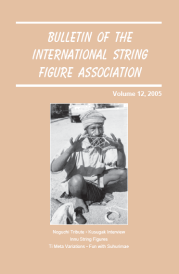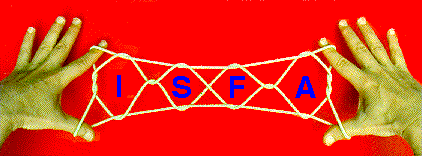Volume 12 (2005): 190 pages - Table des Matières
Edité par - Mark A. Sherman, Pasadena, California
Rédacteurs Associés - Joseph D'Antoni, Queens, New York; Myriam Namolaru, Haifa, Israel;
Belinda Holbrook, Davenport, Iowa; Stephan Claassen, Best, Netherlands.
Comité de Rédaction - Hiroshi Noguchi, Tokyo, Japan; Philip Noble, Inverness, Ecosse
Le Bulletin de l'Association Internationale du Jeu de Ficelle (BISFA) est une publication savante
présentant des documents originaux qui fait progresser notre compréhension et renforce
notre plaisir des jeux de ficelle. BISFA est publié annuellement, en septembre, par ISFA Press
(Pasadena, Californie). BISFA remplace le Bulletin de l'Association des Jeux de Ficelle,
(Toky Nippon Ayatori Kyokai), qui a été publiée en 19 volumes (1978-1993).
Les traductions proposées ne comprennent pas les illustrations et photos du texte original.
J'ai traduit ces textes pour vous donner un aperçu de la qualité et de la richesse de
ces publications.

Tribute
- Quinze Années pour Ayatori , par Hiroshi Noguchi, Tokyo, Japon (pages 1-56) - Un récit An autobiographique des 14 années du Dr. Noguchi en tant que premier directeur d'ISFA. Illustré abondament avec des photographies.
Interview
- Michael Kusugak: Tisseur d'Histoire Ficelées Inuites , par Michael Pollock, Calgary, Alberta, Canada (pages 57-65) - Lorsque le conteur inuit acclamé Michael Kusugak a visité visited le Musée Glewbow de Calgary en 2003, il a réalisé plusieurs jeux de ficelle traditionnels qu'il a appris enfant à Repulse Bay dans l'ArtiqueCanadian. Le member d'ISFA Michael Pollock a saisi l'oportunité pour l'interviewer.
Research Report
- Innu String Figures and Tricks, collected by Frederick W. Waugh (1872-1924), edited and illustrated by Mark Sherman, Pasadena, California (pages 66-147) - In 2001 the ISFA published an article on Ojibwe String Figures and Tricks gathered by Canadian ethnographer Frederick W. Waugh between 1916 and 1920. It was celebrated for being the first major Native American string figure collection ever made among a tribe that speaks an Algonquian language. Here we present yet another major collection that F. W. Waugh made while working among an Algonquian-speaking tribe, this being the Innu (Montagnais-Naskapi), a tribe that traditionally occupied the vast interior region of the Québec-Labrador peninsula. The collection, assembled at Sept-Iles (Seven Islands) during the summer of 1924, consists of twenty-five string figures and one string trick. Surprisingly, only a small percentage are similar or identical to figures gathered among the linguistically related Ojibwe, who live south of Innu territory: most are related to figures gathered among the linguistically unrelated Inuit (Eskimos), who live north of Innu territory.
Modern String Figures
- New Figures from the Ti Meta Opening, by Carey C.K. Smith, Stratford, New Zealand (pages 148-153) - Retired physician Carey C.K Smith has been making string figures for over eighty years. In this short article he describes five new string figures he created that begin with an opening borrowed from a design that is widely distributed in the South Pacific — ‘Ti Meta’ (the Ti Bird’s Nest).
- On s'amuse avec Suhurimae: Variations d'un jeu de ficelle des Iles Solomon , par Mark Sherman, Pasadena, Californie (pages 154-176) - Suhurimae est un jeu de ficelle original des Iles Solomon, qui a une boucle ovale au centre. Pour exprimer leur affection pour cette figure, les iliens ont créé une variation qu'ils ont appelée Porotoutouta’a. Des années plus tard, Tom Storer a créé sa propre variation qu'il a nommée Suhurime. Dans cet article l'auteur présente dix-sept autres variations, qu'il a créées pour célébrer la retraite de son mentor bien-aimé, le Professeur Tom Storer.
Book and DVD Reviews - by Mark Sherman (pages 177-183)
- Na’atl’o’: Navajo String Games, by Don Mose, Jr.
- La Pita: Juego Ancestral, by Rubיn Darםo Huapaya Amado.
- Ein Faden verbindet: Weltumspannende Fadenspiele, edited by Anka Bolduan, Heidemarie Menge, and Maren Rahlf.
- Hei: Hawaiian String Figures, performed by Lois and Earl Stokes. (DVD)
- Le Coeur du Singe: The Monkey’s Heart (Anne Glover Raconte! Volume 1) , par Anne Glover. (DVD)
- African String Figures (Jeux de Ficelle Africains) , par David Titus.
Letters to the Editor (pages 184-190)
- Li, not Rii - Yukio Shishido. Comment about a photo published in ISFA Bulletin vol. 1 (1994).
- Le Dernier Rire de l'Ane Riant - Yukio Shishido. Commentaire sur un jeu de ficelle qui est paru dans le Magazine du Jeu de Ficelle (Mars 2000) que l'éditeur a mal interprété.
- Kenshu, not Tatsuhide - Tetsuo Sato. Correction about an article that appeared in ISFA Bulletin vol. 3 (1996).
- Ladder Patter II - Bob Grimes. Second letter about mnemonic rhymes that help performers remember the steps in making Jacob's Ladder.
- Stamp-sized String Art - Carey C.K. Smith. Brief account of a miniature string figure that was presented to the author as a gift. It was woven with the help of two forks, whose tines served as fingers.
- Not just Whistling Dixie - Lynn Bacon-Trzcinski. Brief account of childhood string figures once known in rural Alabama.
- Conseils contre le Trac - Camilla Gryski. Quelques conseils rapides, glanés des années d'exprience, sur la manière d'enseigner des jeux de ficelle à un grand froupe d'enfants.
- Héritage de la Ficelle de Toronto - Ken McCuaig. Souvenirs de Thomas McIlwraith, un anthropologue Professeur aà l' Université de Toronto.
- Moose for a King - Lori King. Instructions for making an invented string figure that represents a Canadian moose.
Ajouter un commentaire






